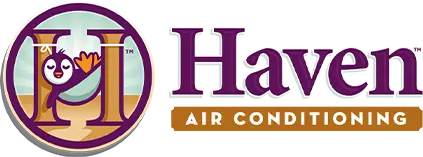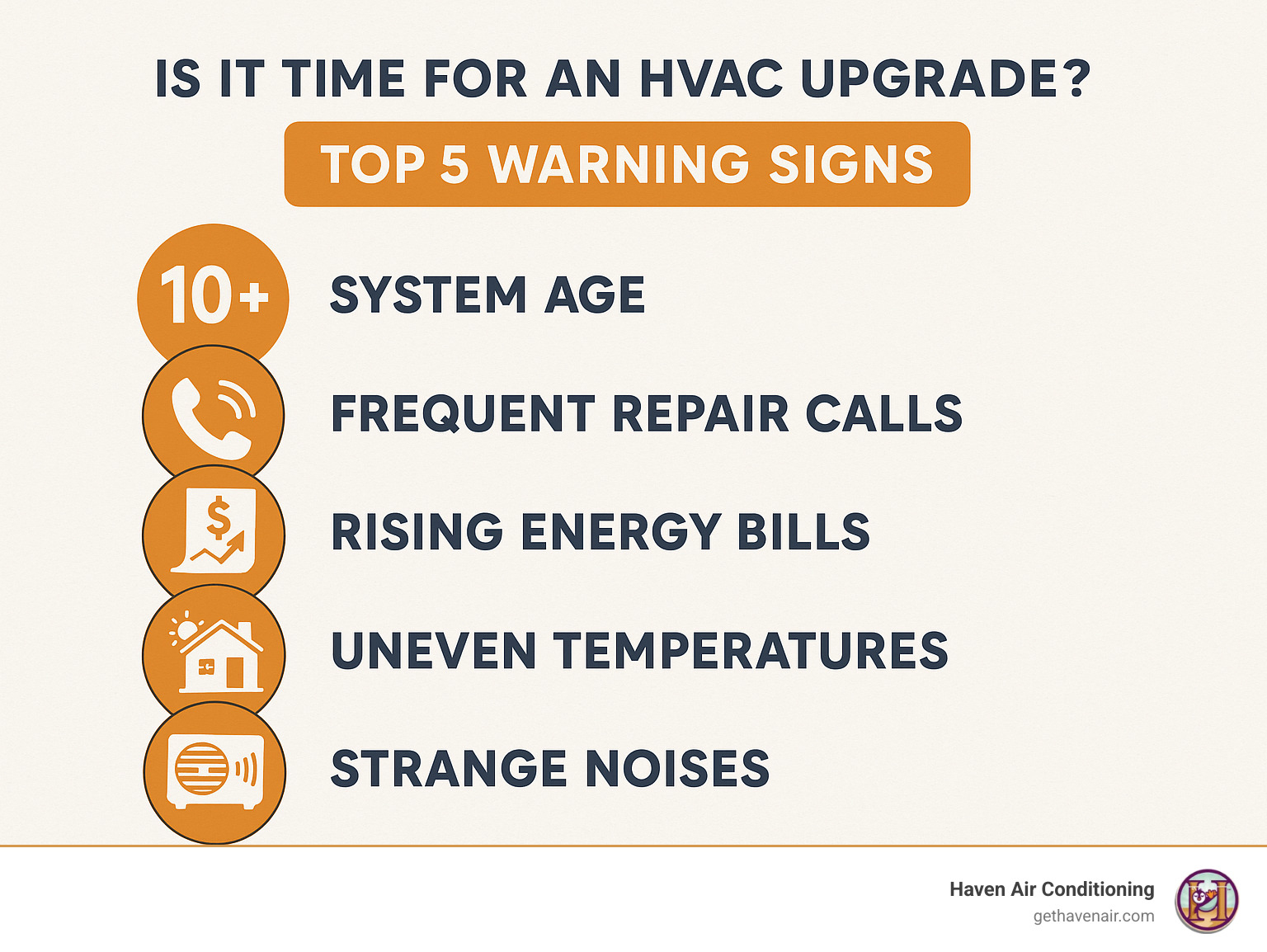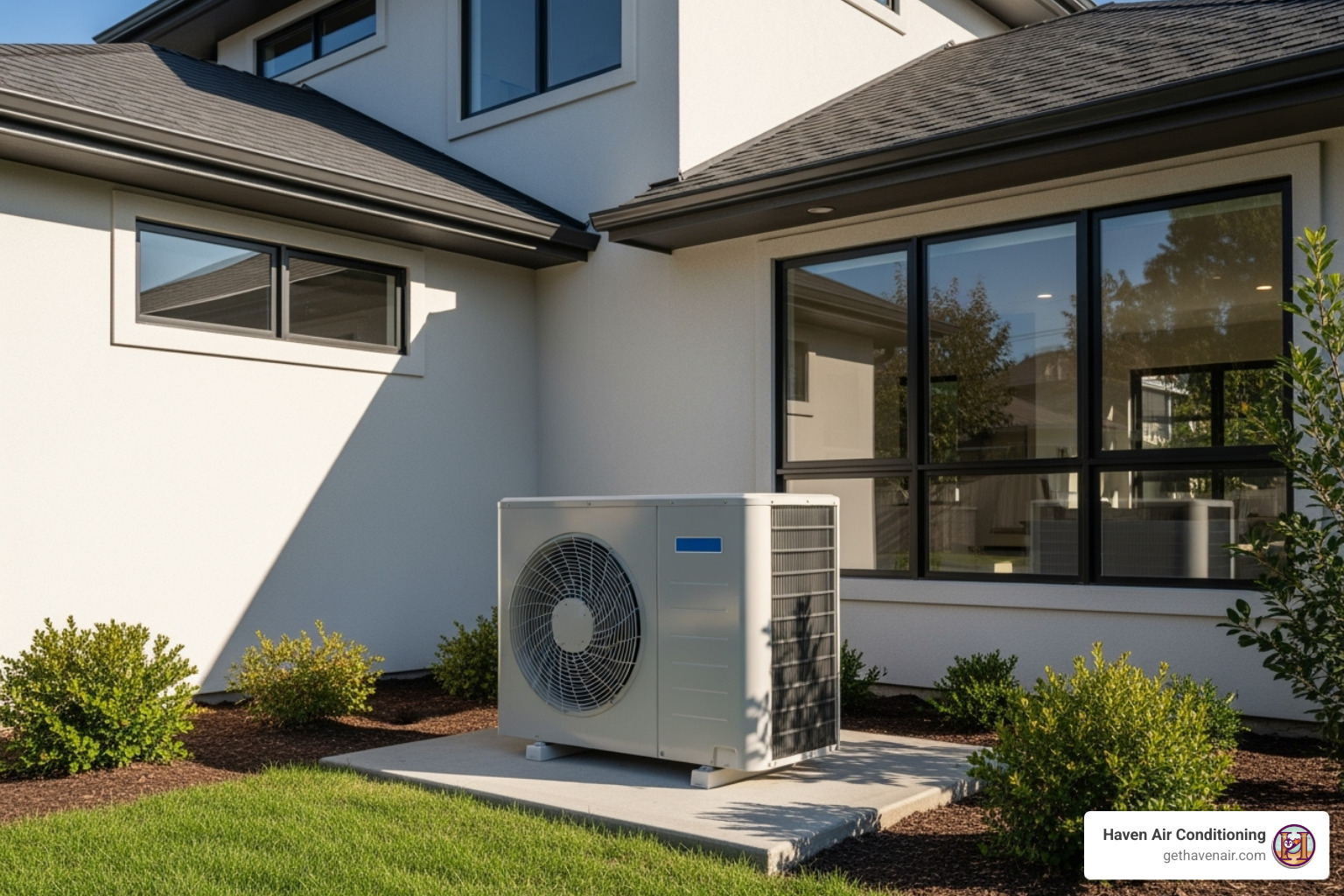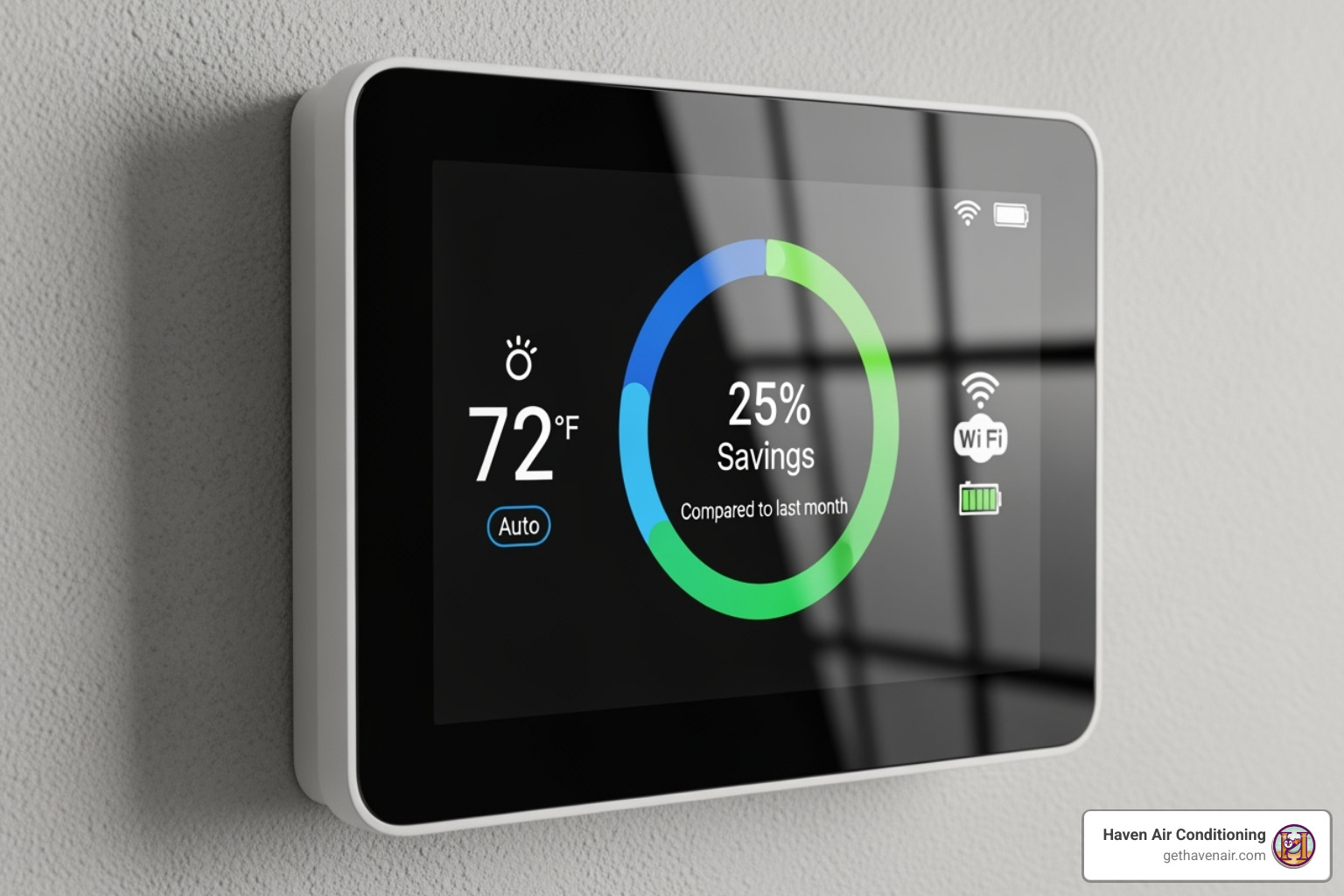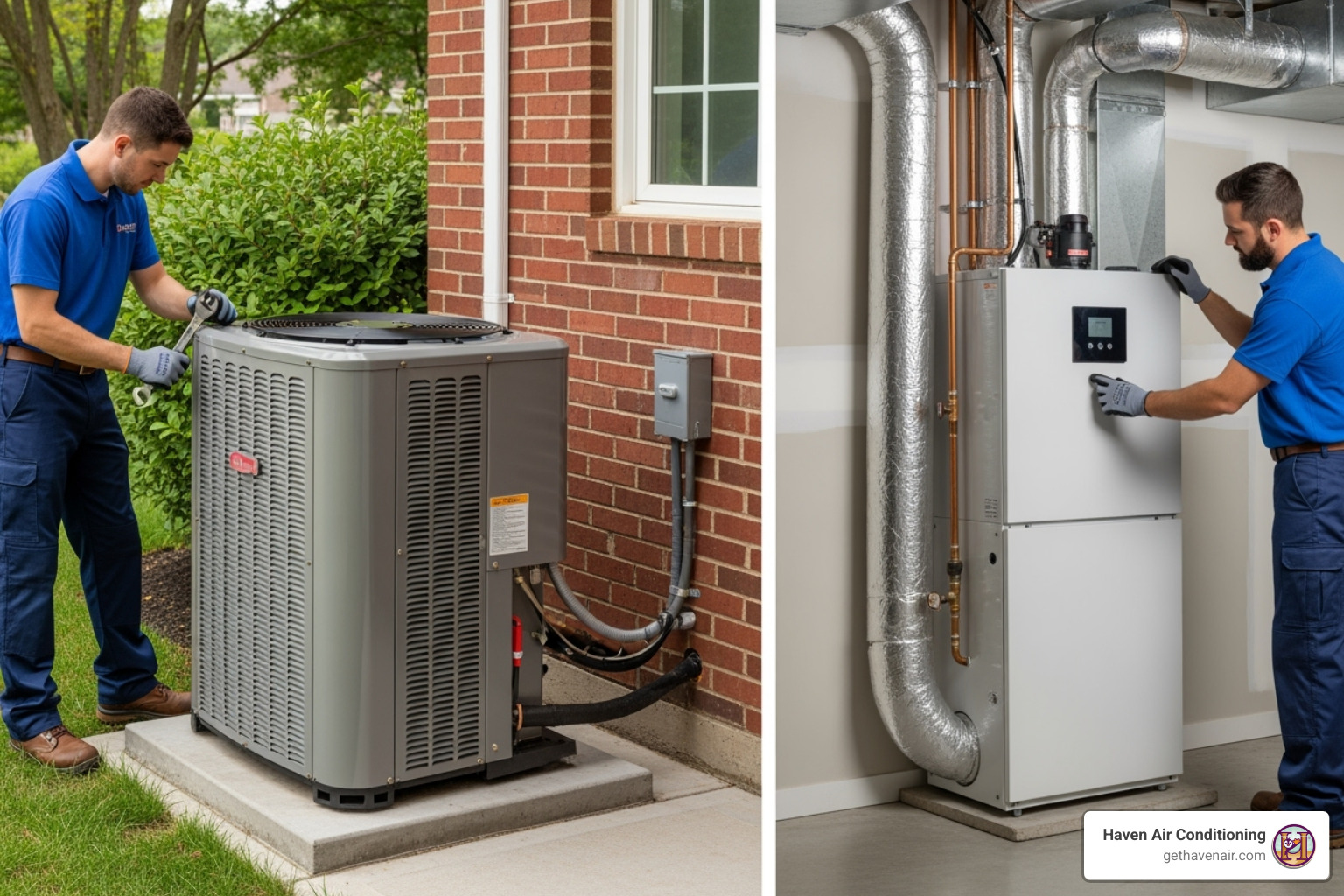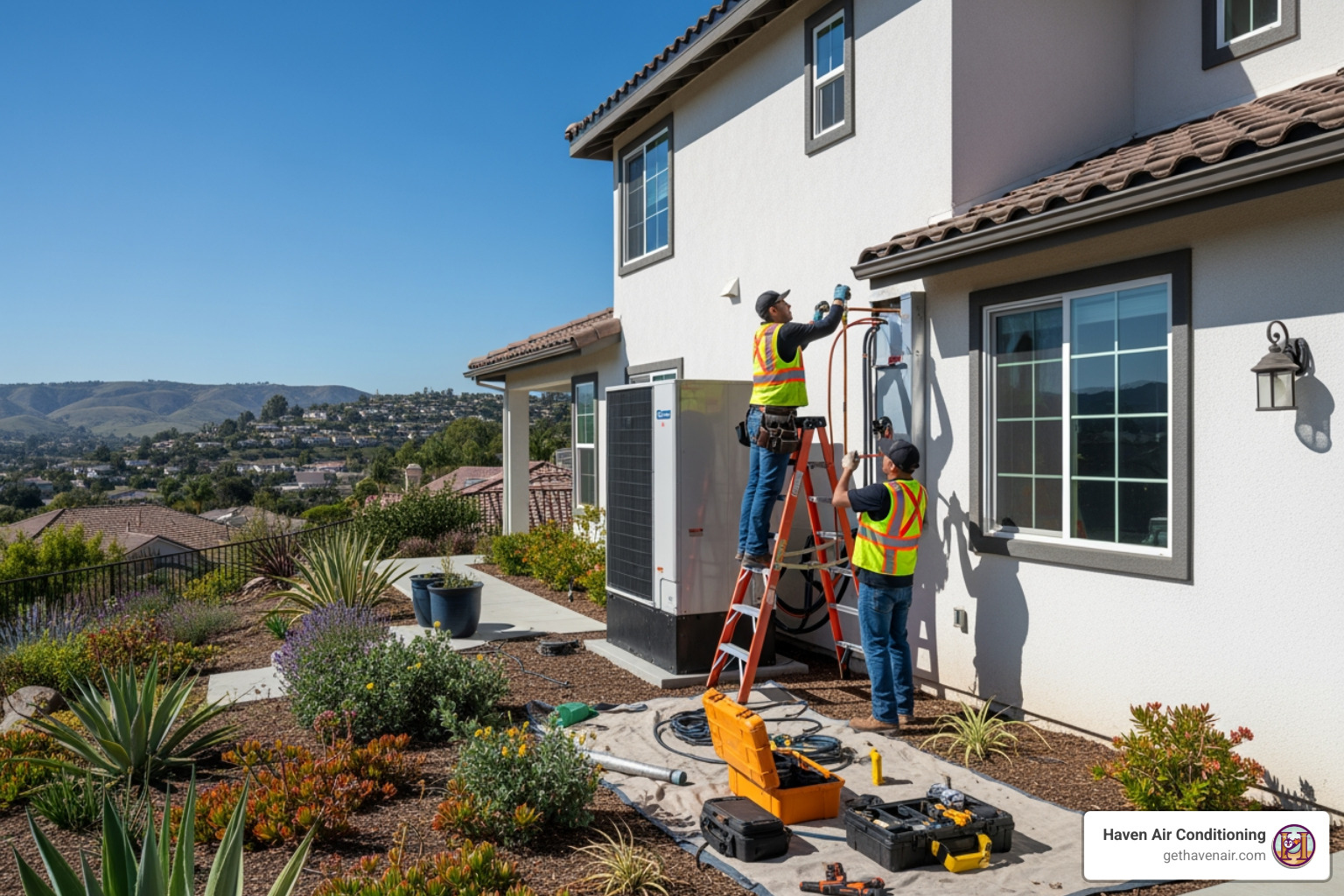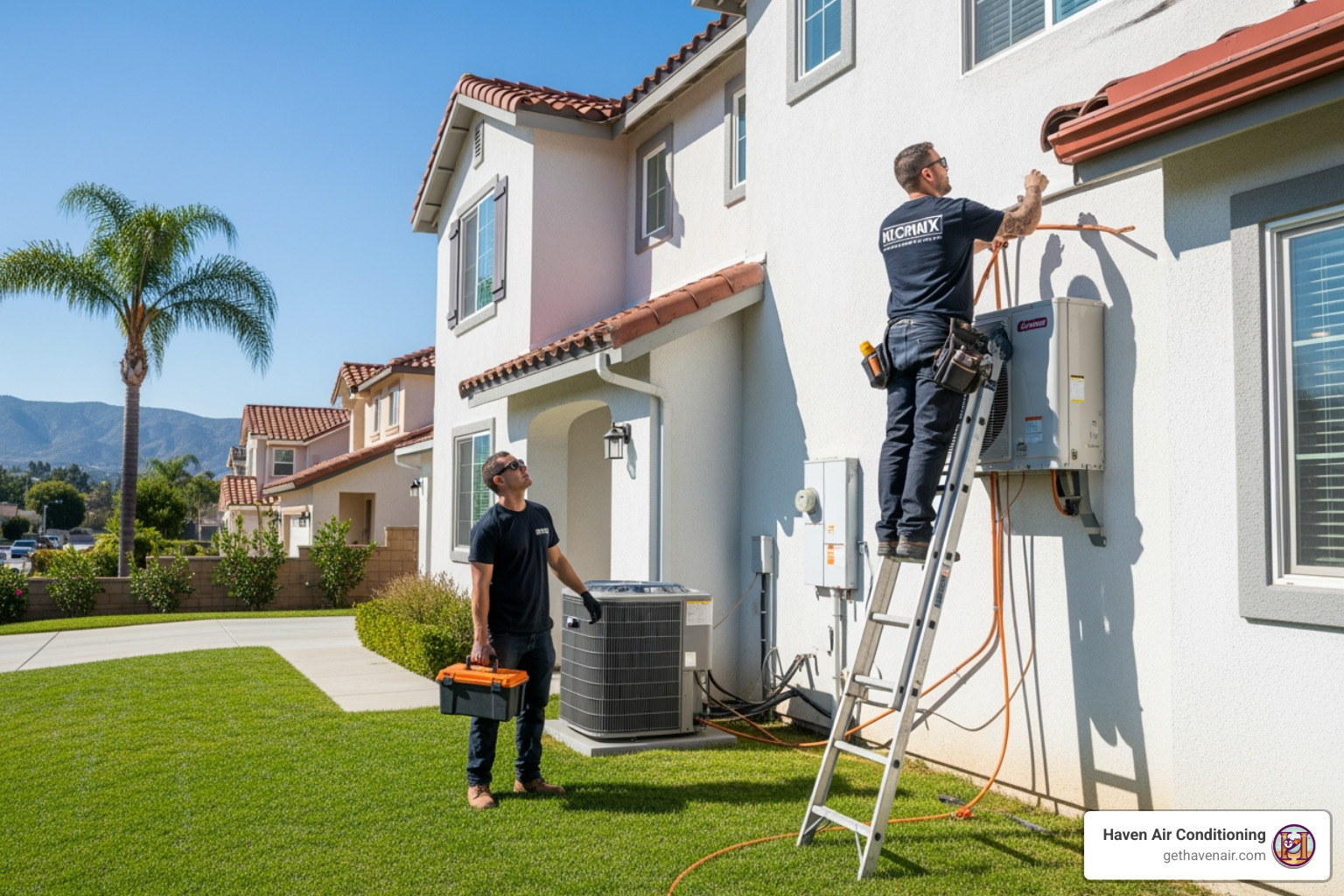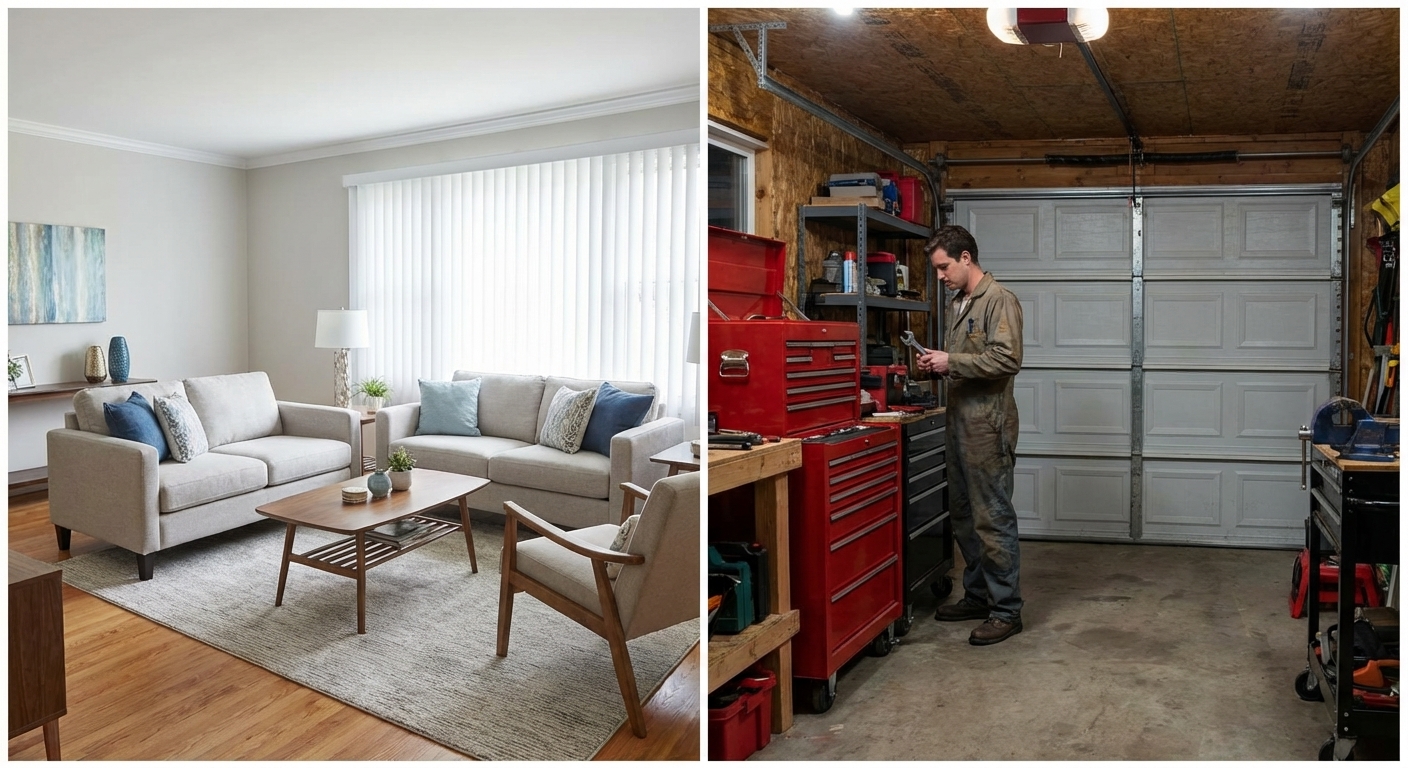Why HVAC System Upgrades Are Essential for Modern Homes
An HVAC system upgrade can transform your home’s comfort and slash your energy bills by up to 40%. If you’re dealing with rising utility costs, inconsistent temperatures, or an aging system, it might be time to consider an upgrade.
Key indicators you need an HVAC system upgrade:
- System age: 10-15 years or older
- Frequent repairs: Calling for service multiple times per year
- Rising energy bills: 20-40% higher than they should be
- Poor comfort: Hot and cold spots throughout your home
- Outdated technology: Using banned refrigerants like Freon
- Strange noises: Squealing, banging, or rattling sounds
The decision to upgrade isn’t just about fixing what’s broken; it’s an investment in your home’s future. Modern systems offer dramatically improved energy efficiency, with high-efficiency models reducing energy costs by 20% or more compared to older units.
An aging system costs you money every month. The Department of Energy suggests replacing HVAC systems after 10 years to maintain optimal efficiency. Even a system that “still works” may be using far more energy than necessary.
Beyond financial benefits, today’s HVAC technology offers features unavailable in older systems, like smart thermostats, zoning for personalized comfort, and advanced air purification for a healthier home.
Quick HVAC system upgrade definitions:
Is It Time for an HVAC Upgrade? Key Warning Signs
Your home has a way of telling you when it’s time for an HVAC upgrade. Recognizing these warning signs can save you from surprise breakdowns and high energy bills.
System age is the first clue. Most HVAC systems last 10 to 15 years. After a decade, their efficiency declines. The Department of Energy recommends replacement after 10 years to maintain efficiency. If your system is over 10 years old, it’s time to plan for its replacement.
Frequent repairs are another telltale sign. If you’re scheduling service calls multiple times a year, your system is likely failing. These repair bills add up, often making a new system a better investment. Learn more about what repairs signal bigger problems in our guide on Signs You Need Expert HVAC Repair Services.
Rising energy costs are a clear indicator. If your utility bills are climbing, your aging HVAC system is the likely culprit. As systems age, they work harder to heat or cool your home, consuming more energy. An HVAC system upgrade can lead to dramatic savings.
Strange noises like squealing, banging, or rattling mean something is wrong. These sounds often signal worn-out or loose parts that could lead to major breakdowns.
Uneven heating and cooling results in hot and cold spots. This indicates your system can no longer distribute air properly due to age, improper sizing, or declining capacity.
Poor indoor air quality and humidity issues are often overlooked. If your home feels dusty, stuffy, or humid, your system isn’t doing its job. Systems using outdated technology like Freon (R-22 refrigerant) are especially problematic, as this refrigerant has been phased out, making repairs expensive and replacement inevitable.
Staying ahead of these warning signs prevents discomfort and unexpected costs.
The Overlooked Benefits of a Modern HVAC System
A modern HVAC system upgrade delivers benefits that go far beyond simply restoring heating or cooling. It’s an investment in your home’s overall performance and your family’s well-being.
Here are some of the key benefits you can expect:
Dramatic Energy Savings. The Department of Energy reports that upgrading your HVAC system can reduce utility bills by 20–40%. High-efficiency systems use advanced technology to turn what was once wasted energy into real savings.
Consistent Home Comfort. Modern systems with variable-speed technology eliminate hot and cold spots by running at different capacities to maintain steady temperatures throughout your home.
Healthier Indoor Air. Today’s systems can integrate advanced filtration to capture allergens, dust, mold spores, and viruses that older systems miss. This improvement can be life-changing for families with allergies or respiratory issues. Our article on Why IAQ Matters During AC Installation explains how to maximize these health benefits.
Smart Home Convenience. Modern HVAC systems connect with smart thermostats that learn your schedule, send energy reports, and alert you to maintenance needs, often adjusting automatically to save energy.
Reduced Carbon Footprint. Using 20-40% less energy means your new system is better for the environment and your wallet.
Increased Home Value. Energy-efficient HVAC systems are major selling points for homebuyers. An upgrade can increase home value by up to 10%, making it an investment that pays dividends if you decide to sell.
An HVAC system upgrade is about improving your quality of life at home. From the moment it’s installed, you’ll notice the difference.
Your Comprehensive Guide to an HVAC System Upgrade
Choosing a new HVAC system upgrade involves many technical details. This guide breaks down the essentials to help you make an informed decision for your Orange County home, covering everything from system types to efficiency ratings.
Choosing the Right Type of System
The first step is choosing the right system type for your home. Each option has unique strengths.
| System Type | Initial Cost (parts only, excluding installation) | Efficiency (general) | Best Use Cases |
|---|---|---|---|
| Central HVAC (Furnace/AC) | ~$4,700 (furnace), ~$7,000 (AC) | Mid-High (80-95% AFUE, 13.4-20+ SEER2) | Homes with existing ductwork, whole-home comfort, traditional heating/cooling. |
| Ductless Mini-Splits | ~$1,200 per head (parts) | High (18-30+ SEER) | Home additions, zoned comfort, homes without ductwork, single-room heating/cooling needs. |
| Heat Pumps | ~$7,000 (parts) | Very High (17-20+ SEER2, 8-13+ HSPF) | All-electric homes, mild climates, energy-efficient heating and cooling in one unit. |
Note: Costs are estimates for parts only and do not include installation, which can significantly increase the total project cost. Actual costs vary widely based on brand, features, and local market conditions.
Here’s a closer look at each system:
-
Central Forced Air Systems: The traditional choice, these systems use a furnace and air conditioner to distribute air through ductwork. Upgrading is often straightforward for homes with existing ducts. We can help you find the ideal setup among the various Types of HVAC Systems.
-
Ductless Mini-Splits: Perfect for homes without ductwork or for zoning specific areas like additions or sunrooms. They connect an outdoor unit to one or more indoor air handlers for targeted, efficient comfort. We specialize in Ductless Cooling solutions.
-
Heat Pumps: These highly efficient systems move heat rather than creating it, providing both heating and cooling in one unit. They are an excellent all-electric choice for Orange County’s mild climate, and modern versions perform well even in colder weather.
Key Factors for Your HVAC System Upgrade
Once you have a system type in mind, consider these key factors to ensure optimal performance and savings.
-
SEER/SEER2 and AFUE Ratings: These ratings measure efficiency. Higher numbers mean greater savings.
- SEER (Seasonal Energy Efficiency Ratio) and SEER2: These measure cooling efficiency for air conditioners and heat pumps. The minimum SEER2 is 13.4, but higher-rated units offer better long-term savings.
- AFUE (Annual Fuel Utilization Efficiency): This measures furnace efficiency. An 80% AFUE furnace converts 80% of fuel to heat. Look for high ratings, especially ENERGY STAR-certified equipment, to lower energy costs.
-
System Sizing (Load Calculation): This is the most critical step. A system that’s too big will short-cycle, failing to dehumidify properly. A system that’s too small will run constantly without reaching the desired temperature. A professional load calculation assesses your home’s size, insulation, windows, and climate to ensure the system is sized perfectly for optimal comfort and efficiency. Learn more in our guide to Proper Sizing for Home AC Split Mini Systems.
-
Smart Thermostats: These Wi-Fi-enabled devices learn your habits to automatically adjust temperatures for comfort and energy savings. They can provide energy reports and work with smart home assistants, making them a ‘downright genius’ addition to your HVAC system upgrade.
-
Zoning Capabilities: Zoning divides your home into different temperature ‘zones,’ each with its own thermostat. This saves energy by not heating or cooling unused rooms and provides personalized comfort for different areas of the house. Explore the benefits of HVAC Zoning.
-
Air Purification and Humidity Control: An upgrade is a perfect time to improve indoor air quality (IAQ).
- Air Purification: Add-ons like high-efficiency filters (HEPA), electrostatic filters, or UV lights can be integrated to remove allergens, dust, odors, and germs.
- Humidity Control: Whole-home humidifiers add moisture in winter to combat dryness, while dehumidifiers remove excess moisture in summer. Maintaining around 50% humidity improves comfort and prevents mold.
Handling Special Cases: Home Additions and Retrofitting
An HVAC system upgrade may involve more than a simple replacement.
-
Home Additions: A new room adds to your HVAC system’s workload. A professional load calculation is crucial to determine if your current system can handle the extra space. Options include extending existing ductwork with expert Duct Installation or installing a separate ductless mini-split for the new zone.
-
Retrofitting vs. Replacement: Should you upgrade parts or replace the whole system?
- Replacement is often best for old, inefficient, or unreliable systems.
- Retrofitting involves upgrading components of your existing system, like adding a new AC coil. This can be cost-effective if only a few parts are worn. However, for systems using outdated refrigerants (like Freon) or with multiple failing parts, a full replacement is the smarter long-term investment.
The Upgrade Process: Costs, Financing, and What to Expect
So, you’ve recognized the signs and explored the options. Now comes the practical part: getting your HVAC system upgrade installed. We believe in clear communication to make this process as smooth as possible.
The Financials of an HVAC System Upgrade
An HVAC system upgrade is a significant investment that pays you back over time through energy savings and increased home value.
Equipment costs can range from around $4,700 for a furnace to $7,000 for an AC unit or heat pump, with ductless mini-split heads around $1,200 each. These are parts-only estimates. A full central HVAC system upgrade, including professional labor and materials, could range from $8,000 to over $19,000. While this seems high, the long-term savings are substantial.
To make your upgrade more affordable, explore local utility rebates and Federal tax credits for high-efficiency equipment. These incentives can significantly offset the initial investment.
We also offer flexible Financing Promotions to fit your budget, helping you enjoy better comfort and lower bills sooner.
The return on investment (ROI) is impressive. By cutting utility bills by 20-40%, your new system can pay for itself over time. You also gain improved comfort, cleaner air, and a boost in property value.
The Installation Process
Proper installation is as important as the equipment itself. Our certified team at Haven Air Conditioning ensures your installation is seamless and professional.
Your journey starts with choosing a contractor. Look for certified, licensed, and insured professionals with a reputation for quality. Our guide on Choosing Professional HVAC Installation offers more tips.
Next is pre-installation prep. Our team conducts a thorough assessment, including a precise load calculation, and discusses any necessary ductwork or electrical modifications to prevent surprises.
On installation day, our technicians will arrive on time, carefully remove your old system, and expertly install the new unit, connecting all components with precision while minimizing disruption. Our guide on What to Expect During HVAC Installation details the process.
After installation, we perform thorough post-installation checks, testing refrigerant levels, airflow, and overall performance. We’ll also walk you through operating your new system and answer any questions.
Finally, your HVAC system upgrade is protected by a warranty and aftercare support. We’ll explain the manufacturer’s HVAC Warranty and offer maintenance plans to protect your investment for years to come.
Frequently Asked Questions about HVAC Upgrades
Homeowners naturally have questions about an HVAC system upgrade. Here are answers to the most common ones we hear in the Greater Orange County Area.
How long does a typical HVAC system last?
Most HVAC systems, including furnaces and air conditioners, have a lifespan of 10 to 15 years. While a system might still function after a decade, its efficiency drops significantly. Regular HVAC Preventive Maintenance helps, but eventually, an upgrade becomes the smarter financial choice, especially when repair costs and energy bills rise.
What is the most important factor when choosing a new HVAC system?
Proper sizing is the most critical factor. A system that’s too large will short-cycle, failing to dehumidify your air properly. An undersized system will run constantly, driving up energy bills without providing adequate comfort. A professional load calculation, which considers your home’s insulation, windows, and more, is essential before any AC Installation to ensure optimal performance.
Can I upgrade just my air conditioner or furnace?
Yes, you can replace just one component if the other is still in good shape. However, if both your heating and cooling units are of a similar age (around 10 years or older), we often recommend replacing them together. Modern systems are designed to work as matched pairs for optimal efficiency and performance. Understanding How Heating and AC Systems Work Together is key. Replacing both at once can also save on labor costs compared to two separate installations.
Conclusion
Investing in an HVAC system upgrade is one of the smartest moves for your home, enhancing comfort, lowering energy bills, and adding property value.
We’ve covered the key warning signs (age, repairs, high costs), the incredible benefits of modern systems (20-40% energy savings, smart features), and the technical factors like proper sizing and efficiency ratings. With financing options and rebates available, a new system is more accessible than you might think.
At Haven Air Conditioning, we help families across the Greater Orange County Area make these decisions with confidence. Our certified technicians provide expert installation with exceptional customer service and attention to detail, ensuring the entire process is smooth.
Whether you’re in Anaheim, Irvine, Santa Ana, or another community we serve, we are here to guide you. From the initial consultation to professional installation and ongoing maintenance, we are committed to your family’s comfort and reliability for years to come.
Ready to transform your home’s comfort and start saving? Contact Us today for a professional consultation. Let’s find the perfect HVAC solution for your home.
